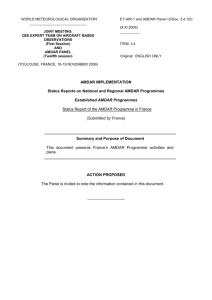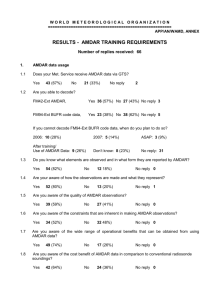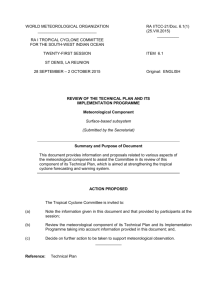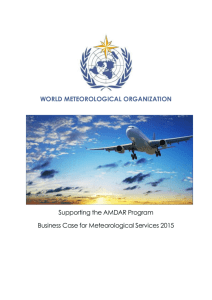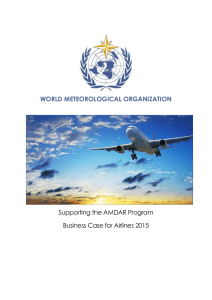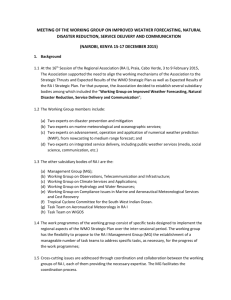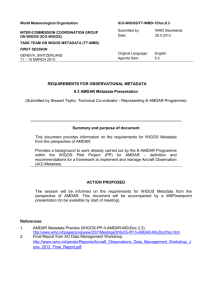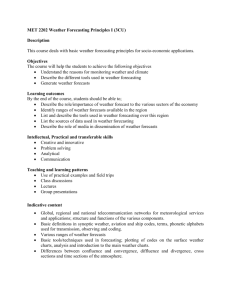Business case template for programme funder
advertisement
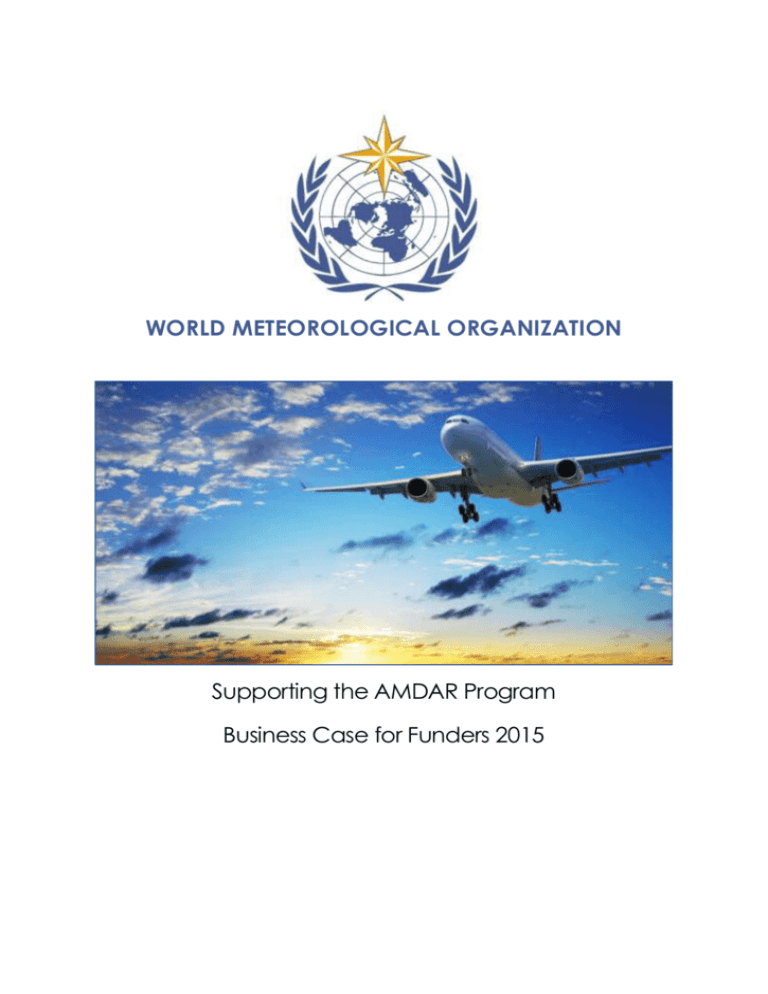
WORLD METEOROLOGICAL ORGANIZATION Supporting the AMDAR Program Business Case for Funders 2015 EXECUTIVE SUMMARY This document presents and describes the case for supporting the AMDAR program of the World Meteorological Organization, a specialized agency of the United Nations dedicated to weather, water and climate. The AMDAR (Aircraft Meteorological DAta Relay) program, a partnership between the private sector, government entities and the WMO, delivers a range of economic, social and environmental benefits to stakeholders across the following sectors: Environmental protection Agriculture Health Disaster risk reduction Aviation This document is intended for use by organizations that may be interested in financially supporting the program. 2 I. AMDAR OVERVIEW BACKGROUND The Aircraft Meteorological DAta Relay (AMDAR), program overseen by the World Meteorological Organization (WMO), fosters partnerships between airline companies, weather monitoring and forecasting organizations and other relevant stakeholders. The program uses commercial aircraft’s existing sensors, avionics, and global telecommunications systems to gather, analyze and disseminate data that improves the frequency of weather reporting and the accuracy of weather forecasting.1 The AMDAR system uses sensors on commercial aircraft, such as Korean Air or South African Airways passenger planes, to collect and distribute key meteorological data (wind speed and direction, temperature, etc.) during flight, for improved weather reporting and forecasting worldwide. Automated weather observations by aircraft were first used in 1978, with the first operational AMDAR program beginning in 1986 with just 5 aircraft. Growth has been rapid, as seen in Figure 1 below. To date, the program has grown to include 39 participating airlines and over 3800 commercial aircraft worldwide. Participating airlines include American Airlines, Air Vanuatu, Korean Air, Lufthansa, Shandong Airlines, British Airways, KLM, Cathay Pacific, South African Airways, and Qantas Airways.2 Figure 1 – Global aircraft observations – average of daily report totals3 The growing number of airline partners and AMDAR-equipped aircraft within existing airline fleets are a testament to the value of the program for airlines and the airline industry overall. Compared with other weather monitoring and reporting systems, AMDAR is also a highly cost effective solution, in most cases requiring only the deployment of an avionics software application. For example, an average AMDAR program, utilizing 30 aircraft, is estimated to be no more than 20% of the cost of a comparable radiosonde program (a system which utilizes weather balloons and telemetry instruments to collect atmospheric data).4 Indeed, a recent 1 WIGOS – The Benefits of AMDAR data to Meteorology and Aviation Report 2014 (“WIGOS Benefits Report”) 2 AMDAR program website: http://www.wmo.int/pages/prog/www/GOS/ABO/AMDAR//AMDAR_Airlines.html 3 http://www.wmo.int/pages/prog/www/GOS/ABO/data/statistics/aircraft_obs_cmc_mthly_ave_daily_reports_by_type.jpg 4 This assumes the AMDAR program is equipped with humidity sensors such as WVSS-II. WIGOS Benefits Report 3 Met Office cost-benefit analysis of different observing systems 5 found AMDAR to give the highest impact per cost on a global numerical weather prediction model. AMDAR PROGRAM OPERATION AMDAR utilizes aircraft’s onboard instruments and avionics systems to provide accurate meteorological measurements, such as air temperature and winds. This data is transmitted to the ground usually by VHF radio or satellite, and from ground stations to meteorological processing centers via the airline’s data processing center. 6 Information on the following parameters is collected at all phases of flight7 as standard: – Altitude (pressure derived) – Temperature – Wind speed – Wind direction Additional parameters which can be optionally collected by participating airlines include: – Humidity – Turbulence These additional parameters require further software application functionality (and in the case of humidity, sensor hardware) – but can improve weather forecasting even further. AMDAR measurements are compiled into a standard message format and transmitted to the partner national weather center, or National Meteorological and Hydrological Services (NMHS), in as near to real-time as possible. Figure 2 – Schematic of the basic AMDAR system* * Reflects major service providers contracted by participating airlines. National service providers, such as Brazil and China, also participate in the program. More detailed information on the AMDAR observing system is available from the WMO AMDAR website (http://www.wmo.int/pages/prog/www/GOS/ABO/AMDAR/About.html). 5 Eyre, J. and R. Reid, 2014: Cost-benefit studies of observing systems. Met Office, UK 6 Data transmitted from aircraft using ACARS (Aircraft Communications Addressing and Reporting System). AMDAR Coverage and Recruitment Study 2013 7 EUMETNET AMDAR presentation at Royal Meteorological Society 2013 4 II. BENEFITS OF AMDAR AND IMPROVED FORECASTING How AMDAR Improves Forecasting AMDAR observations are used in the production, verification and assessment of predictive weather models and forecast products and diagnostics, the results of which contribute to an improvement in model performance and predictive skill – and also to helping forecasts continuously improve. AMDAR data has been proven effective in improving the quality and accuracy of weather reports – reducing forecast errors by up to 20%. AMDAR data has become the second 8 , 9 or third 10 most important data set globally for improving 24 hour forecasts, depending on the study – and the data source with the most consistent impact. Further, AMDAR is unique as the only source of in situ upper air data taken throughout the day (rather than at set times) providing both temperature and wind observations11. AMDAR also plays an important role in verifying forecasts and the models used to create them, in particular when the output of a model has to be corrected on the basis of recent AMDAR information. Aviation and public weather forecasters also make use of AMDAR data for both the verification and updating of forecasts in the shorter-term and in the periods between updates of forecasts based on predictive models (usually made every 6 or 12 hours). This advantage and resulting enhancement to forecast skill is derived from the high temporal availability of AMDAR data (often as frequent as one or more vertical profiles per hour).12 The data continues to have a positive impact on forecasts up to 48 hours out. The accuracy, high reporting volume and frequency and timeliness of AMDAR data make it an important factor in improved weather monitoring and prediction, which has a wide range of benefits and beneficiaries – both including and beyond the aviation industry. Improvements in forecasts, enabled by AMDAR data, deliver a wide range of economic, social and environmental benefits for participating organizations, countries, and regions. At the national level, AMDAR-enabled reporting allows public, private and civil society organizations to plan and respond more reliably to impacts of weather-related events. In rural Africa alone, it is estimated that over 700 million poor people are negatively impacted by the lack of reliable weather information. 13 Thus, AMDAR-enabled weather reporting presents significant opportunities and benefits to: The Environment Agriculture Health Disaster Risk Reduction Aviation 8 Radnoti, G. et al, 2010: ECMWF study on the impact of future developments of the space-based observing system on Numerical Weather Prediction 9 Taking satellite observations as a single data set 10 Petersen, R. A., 2014: On the current impact and future benefits of AMDAR observations in operational forecasts 11 Ibid. 12 WIGOS Benefits Report 13 Weather Info for All Concept Paper, WMO, 2008 5 1. Benefits to the Environment AMDAR data, used to improve weather reporting and forecasting, can support airlines in reducing their annual fuel burn, which in turn results in reduced carbon dioxide (CO2) emissions. South African Airways estimates that for every 1000kg of fuel consumed by aircraft, 3100kg of CO2 is emitted. Over a one-year period, South African Airways was able to reduce its fuel consumption using pre- and in-flight route optimization informed by AMDAR data, by 600,000 kg. In turn, this reduced the airline’s CO2 emissions by approx. 2 million kg, or 2000 tons of carbon dioxide that year.14 Other AMDAR-enabled efficiencies which have environmental benefits include the use of continuous descent approach, described later, which reduces both noise and CO 2 emissions; and better targeted use of deicing fluid based on improved forecasting, reducing the environmental impact of operating a plane in cold weather. Additionally, AMDAR data contributes to regional and global efforts to measure and monitor environmental and climatological patterns and trends. Particularly in regions where upper air data is currently scarce but aviation traffic is present, the development of AMDAR will be vital to studying and better understanding the mechanisms for and impacts of climate change at both the regional and global levels. Furthermore, AMDAR observations are taken at altitudes of 200 – 400 hPa (7 - 12 kms) when aircraft are at cruising elevations; and it is at this level where observations are highly relevant for the study of the variability and change in water vapour that are key to understanding climate change15. Should AMDAR be expanded globally, it would assist greatly in assembling a global climatology of atmospheric humidity. 2. Benefits to Agriculture Better forecasting enables more efficient use of agricultural inputs, and can ensure lower crop losses due to extreme weather or natural disasters. Increased accuracy in forecasting also enables the agricultural sector to optimize the post-harvest supply chain. Better temperature and wind information, which influence the migration of locusts, can be used to support (early warning for) locust migration. Locust, in particular the Desert Locust, “poses the greatest threat of all locusts to humans because hopper bands and adults swarms can rapidly arise and migrate, potentially threatening food security in some 60 countries in Africa, the Middle East and Asia”.16 Since very few wind data providing systems are available in Africa, the expansion of AMDAR can be beneficial in seasonal locust migration forecasting. With AMDAR data less available over parts of the world where agriculture plays a larger role in national economies, more direct links between AMDAR data and agricultural benefits are difficult to draw. What is clear, however, is the benefit AMDAR has to forecasts – and the benefits that improved forecasts have to agriculture. The WMO reports that use of weather information can increase agricultural productivity by 20%. In India, the Research Program on Climate Change, Agriculture and Food Security provides improved rainfall data to an insurance company that offers weather insurance to over 50,000 farmers.17 14 South African Airways AMDAR Business Case AMDAR and Climate, R. Boers and J.P van der Meulen, KNMI, Netherlands, May 2011 16 Yale F&ES Bulletin 103 17 “Better rainfall data means Indian farmers have better insurance against crop failure,” Research Program on Climate Change, Agriculture and Food Security, 2013 15 6 3. Benefits to Health Using improved weather information, governments, communities and health NGOs can better prevent the spread of climate-sensitive diseases such as cholera, dengue and meningitis. Rainfall predictions are currently used in East Africa to predict outbreaks of Rift Valley Fever (a mosquito-borne virus) – scientists use weather data to create monthly risk maps of the disease. 18 Again, direct benefit flow from AMDAR to health benefits are difficult to draw given the current coverage of the program. However, in the US, moisture data provided by AMDAR have shown short-range forecast impacts larger than from any other moisture observations. This has enhanced prediction of both the timing and location of precipitation events 19. Annually, approximately 1 million lives are claimed by weather- and climate-sensitive diseases – most of these are children under the age of 5 in developing countries. It is estimated that 23,000 lives could be saved each year through improvements to health resulting from more accurate weather monitoring and forecasting.20 4. Benefits to Disaster Risk Reduction Accurate weather predictions can improve prediction of the scale, location, and severity of extreme weather events, and trigger preventive responses to severe weather and natural disasters. According to the World Bank, between 1970 and 2010, natural hazards were responsible for the deaths of 3.3 million people. 21 In 2011 alone, approximately 206 million people were affected by natural disasters, with an economic impact of USD$366 billion.22 Using weather data can reduce human and economic losses from floods, droughts, storms, and wildfires. In 2008 the International Federation of Red Cross and Red Crescent Societies (IFRC) used seasonal precipitation forecasts to prepare in advance for floods in West and Central Africa. 23 IFRC was able to meet victims’ needs within 24-48 hours of flooding, compared to 40 days the year prior, and the cost of flood response per beneficiary was also 33% lower than in 2006/2007. A recent study has shown that AMDAR data had a greater impact than any other data source on improving forecasts of the location and timing of landfall of Hurricane Sandy in 2012 – double the impact of balloon-carried weather probes (rawinsondes).24 5. Benefits to Aviation and the Airline Industry Improved forecasting services and meteorological products, resulting from the provision of AMDAR data and its inclusion in predictive meteorological models, can have significant positive impact on aviation operations. Examples of weather conditions where improved weather information, owing to AMDAR data, can play a significant role for airlines, airports and air traffic control are25: 18 “Rift Valley Fever,” WHO website, 2014 19 WMO analysis from upcoming paper 20 Weather Info for All Concept Paper, WMO, 2008 21 Weather and Climate Resilience Report, World Bank 2013 22 UNISDRE Report 2011 23 Early Warning, Early Action - Evaluation of IFRC West and Central Africa Zone Preparedness and Response. IFRC, 2008 24 WMO analysis, based on Hoover, Brett T.; Velden, C. S. and Langland, R. H. to NOAA Annual Hurricane Workshop. Miami, FL. https://ams.confex.com/ams/31hurr/webprogram/manuscript/paper243960/7A.3_abstract.pdf 25 WIGOS Benefits Report 7 - - Thunderstorm genesis, location and severity Additional and improved wind information near airports Detection of zero-degree level (freezing rain) Fog formation, location and duration Turbulence location and intensity Conditions leading to aircraft icing By providing more frequent and accurate insight into the above conditions, AMDAR data allows stakeholders in the aviation industry to better prepare for weather patterns and changes in order to improve their operations – and ultimately reduce costs. More specifically, AMDAR-enabled reporting and forecasting have a wide range of benefits for both individual airlines as well as the airline industry overall. These include: - More efficient flight operations: optimized flight plans to avoid turbulent weather and unplanned diversions for reduced fuel consumption, minimized wear and tear on aircraft thereby increasing their useful life and reducing maintenance costs - Reduced carbon footprint: lower aircraft fuel burn reduces CO2 emissions, which reduces both emissions costs and environmental damage, as well as improving corporate reputation - Increased safety and passenger comfort: improved route planning allows aircraft to avoid inclement weather which threaten passenger and crew safety, reduces unplanned diversions resulting in fewer delays and cancellations, and reduces airport and customer service costs thereby increasing customer satisfaction and airline patronage “At about 1200c UTC on 6 February 1998 the Miami Centre Weather Service Unit (CWSU) was notified that an airliner had encountered sustained, strong headwinds over the Atlantic that were not taken into account when the plane was fuelled in Italy. The pilot was concerned that they might suffer fuel exhaustion en route. He needed an altitude that offered substantially smaller headwinds because he was approaching critical fuel. Fortunately recent information collected by AMDAR reporting aircraft showed a flight track over the Bahamas less than one hour old with headwinds 40 knots (21 m s-1) less than the winds that the airliner was reporting. Controllers immediately assigned the airliner to that altitude and flight path and the aircraft was able to complete the flight without incident.” The availability of AMDAR data is conservatively estimated to have saved this airline over $10,000 in this one case alone and potentially averted a significant incident. Fuel savings from avoiding an extra descent and ascent for diversion is typically in the range of $3,000. Extra cost of ground support at the diversion point, crew duty limits, passenger accommodations, extra airline operations support, and other costs contribute the remaining. Ref. Bulletin AMS, 84, pp 203-216 8 III. THE FUTURE OF AMDAR The AMDAR program has experienced significant growth in recent years. As of October 2014, nearly 700,000 AMDAR aircraft observations were reported globally, representing a nearly 75% increase over the 2013 observation levels. However, AMDAR participation is currently concentrated in Europe, North America, East Asia and Australasia, resulting in frequent and high quality observations benefitting a range of players in these well-developed markets. Large areas where aircraft-based observations are still relatively infrequent have significant potential for improved weather forecasting. Figure 3 shows vertical profile coverage (data collected during ascent and descent) at 528 airports worldwide, while Figure 4 shows a day’s worth of observations, highlighting differences in data concentration across regions.26 Figure 3 – Vertical Profile data coverage, January 26, 2014 Yellow = less than 1 profile per day Green = 1-7 profiles per day Blue = 8-24 profiles per day Purple = greater than 24 profiles per day Figure 4 – Two-dimensional global aircraft-based observations coverage, March 9, 2015 26 WMO AMDAR data statistics - http://www.wmo.int/pages/prog/www/GOS/ABO/data/ABO_Data_Statistics.html 9 As illustrated in the figures above, significant scope exists to increase aircraft-based meteorological observations throughout Latin America, Africa, and large areas of Central and South Asia where data is relatively sparse. The AMDAR program has the potential to add significant value to weather reporting in these regions for a relatively small cost with far-reaching benefits for private sector, government and civil society actors, as detailed in Section II of this report. AMDAR Expansion AMDAR expansion into the data-sparse regions (Latin America, Africa, and large areas of Central and South Asia), where urbanization growth is expected in the coming decade, will yield greater incremental benefits for developing and emerging markets, which in many cases are more vulnerable to weather-related phenomena than developed economies. Thus, over the coming years, WMO looks to expand the AMDAR program particularly into these regions. WMO has adopted a regional approach for developing and implementing the AMDAR program, aiming at fulfill each region’s specific requirements and is now looking for governments and organizations who share the program’s aims to contribute to and benefit from this expansion. In many cases, participation by certain stakeholders can be impeded by the financial requirements of doing so – whether installation costs or ongoing data communication costs for airlines, or the costs NMHSs must bear to set up an AMDAR program, build human capacity, and use AMDAR data on an ongoing basis in order to improve forecasting. Further, continuing to expand the AMDAR program requires resources in order to raise awareness of the program and its benefits among a broad set of stakeholders. Organizations who recognize the benefits of the AMDAR program can support stakeholders in bearing these costs – whether in expectation of a financial return (e.g. with an instrument with repayments based on the lower costs of operations AMDAR enables) or for the social good and in support of the organization’s mission and vision. Organizations already working directly in weather and climate issues, or in supporting regions with issues that could see direct benefit from AMDAR (agriculture, health, disaster relief, broader environmental issues), can also consider supporting stakeholders with the financial costs of their participation in the AMDAR program. 10 IV. SUPPORTING THE AMDAR PROGRAM While AMDAR operation requires participation from airline companies and National Meteorological and Hydrological Services (NMHSs) in particular, AMDAR expansion into datasparse regions will require support from and collaboration among a number of additional stakeholder groups – some of whom may incur additional costs to participate. There are multiple ways that supporters of the AMDAR program can contribute to and benefit from its expansion. Airline Companies that transmit collected data flights to partner NMHS benefit from improved weather forecasts and boost their public perception through participation – having direct and indirectly measurable effects on their bottom line. Their participation may require a nominal investment in the program to enable participation, and for airlines in areas not covered by VHF, potentially increased costs to transmit AMDAR data via satellite. NMHSs process the data to improve their weather forecasting, benefit from improved quality and frequency of meteorological data, and reduced forecast errors. Participating may require new capabilities and personnel training, and potentially investment in new equipment and communication links. Airports and Air Traffic Control, which could use AMDAR-based products to manage airline traffic and altitude, as well as runway selection, would see improved coordination of air traffic resulting in an increase of overall capacity and a reduction in congestion. This would lead to fewer delays, reduced airport and fuel costs, and increased passenger safety. As with NMHSs, participating may require new capabilities and personnel training, and potentially investment in new equipment and communications links. Aviation authorities, who can oversee, promote or potentially mandate participation in the AMDAR program, would see the benefits to aviation as well as broader socioeconomic benefits as outlined above. External supporters will play an essential catalyzing role in achieving the vision of expansion in the data-sparse regions, which include Africa, Asia and Latin America. The WMO is therefore looking to partner with such organizations. Specific support could include: 1. Supporting NMHSs’ Participation Organizations whose operations or constituents may be affected by weather or climate-related events or patterns can directly support NMHSs in their participation in the program – whether financially or with in-kind assistance. This might enable such supporting organizations access to AMDAR-enabled weather reports in preferential ways, and/or to new or optimized products from NMHSs that better meet their needs. Organizations in sectors such as agriculture, aviation, health, utilities, disaster risk reduction, and environmental protection would find particular benefit in supporting NMHSs’ participation in the AMDAR program. Specific areas where NMHSs would benefit from support include: The setup of regional data processing centers and/or developing requisite communications infrastructure Talent/skills development for the operation of the AMDAR program Other costs in operating, and publicizing the role of the NMHS in, the local / regional AMDAR program 11 2. Supporting Participation of Other Stakeholders AMDAR expansion into developing and emerging markets may require funding support to fill resource gaps or help the stakeholders listed above in financing their participation. Funds will be needed for awareness raising activities, technical development, and collaboration among key stakeholders. Partners can provide funds for: Establishment and ongoing operational costs associated with the program Communications infrastructure installation and operation Data communications charges, particularly satellite communications fees that some airlines may not initially be able to cover – perhaps through an innovative financing instrument (e.g. with a return based on savings on fuel or maintenance the airline may realize as a result of participation) Incentives for airframe and avionics manufacturers to ensure AMDAR capability is standardized or easily retrofit to aircraft Marketing and advertising activities, to increase awareness of the AMDAR program among key stakeholder groups 3. Promoting AMDAR Awareness The WMO seeks to increase awareness of the AMDAR program and its benefits – not only to the meteorological and aviation communities, but also to public, private and civil society actors in target countries, to drive increased participation and program expansion. To this end, the WMO seeks partners willing to support and participate in awareness-generating initiatives for the AMDAR program, such as events and conferences, online marketing efforts, and other promotional activities among partners’ clients or constituent groups. Partners can help to promote the program by: Facilitating stakeholder dialogues through hosting and sponsorship of introductions, meetings and other related events Supporting financially (and/or through in-kind assistance) the development and distribution of AMDAR-related communications materials (across various media channels) Other mechanisms for support may well be available and specific to local NMHSs, airlines and other stakeholders. Regional WMO offices and local NMHSs can advise on the specific needs and context in their areas. CONTACT INFORMATION To find out more about the AMDAR program in your region and how you can support its expansion, contact your regional WMO office or local NMHS (details included below). 12
